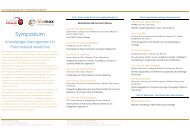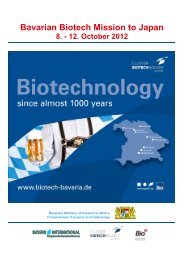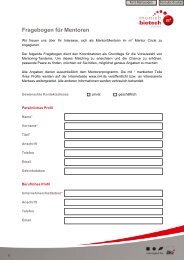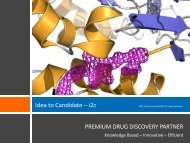Bavarian Biotech Report 2011/2012 (7MB) - Bio M
Bavarian Biotech Report 2011/2012 (7MB) - Bio M
Bavarian Biotech Report 2011/2012 (7MB) - Bio M
You also want an ePaper? Increase the reach of your titles
YUMPU automatically turns print PDFs into web optimized ePapers that Google loves.
The <strong>2011</strong> <strong><strong>Bio</strong>tech</strong> Year in Bavaria –And BeyondOur survey for <strong>2011</strong> still matches with our last theme for the 2010 Annual <strong>Report</strong>: that <strong>Bavarian</strong> biotechnology is right ontrack. The transformation process that it describes – fragmented know-how and specific technology competence unitinginto larger units and thereby consolidating with great intelligence rather than necessity – also continued in a number ofcompanies in <strong>2011</strong>. At the same time, <strong>Bavarian</strong> companies entered into new cooperation agreements or have been able torenew existing ones throughout the year. This confirms the sustained relevance and attractiveness of the technologyplatforms and individual projects on an international scale.With regard to external funding, we would have preferrednot to be as accurate with our supposition that theparticularly positive and record-breaking investmentstotalling around 650 million euros in the German biotechnologysector in 2010 could have been a flash in thepan – albeit a very gratifying one. However, this seeminglydramatic drop to about 140 million euros in <strong>2011</strong>(Source: BIO Deutschland e.V., January <strong>2012</strong>) shows usthat new record levels of investment activity in theGerman biotechnology sector cannot be attained everyyear. When comparing the year <strong>2011</strong> with the rathernormal year of 2009 (investments of about 300 millioneuros) and the previous years, then it appears that theaverage value realistically falls somewhere between 200and 300 million euros. Consequently, <strong>2011</strong> would stillcome close to this apparently typical German average line.However, these numbers turned out to be far morepositive for <strong>2011</strong> on an international and European levelor to USA: According to a PricewaterhouseCooperssurvey from January <strong>2012</strong>, the volume of venture capital(VC) investments in the US biotech sector increased by ahealthy 20% to a five-year high of more than $ 4.7 billion.If we include the areas of medical devices and laboratoryequipment manufacturers, then another 340 US companiesbenefitted from the additional $ 2.8 billion in VCfunds. To invest $ 7.5 billion in innovation makes quite astatement – but firms in the USA also had to realise thatestablished companies benefitted almost exclusivelyfrom this investment bonanza; the proportion of firstround financing was very limited. The VentureValuationcompany broke these numbers down into more detailand added all available forms of funding directed to thepure drug and diagnostics developers, which resulted inabout $ 3.5 billion for the USA. For Europe, VentureValuationcalculated that the total value of all investments tothose companies was somewhat more than $ 1 billion for<strong>2011</strong>. When considering the US dollar to euro exchangerate, Germany attracted about 20% of funds that wereinvested across European companies to its own firms –which may spark a debate as to whether this was anappropriate share or too modest.In any case, Bavaria was able to chalk up more thanhalf of the rather meagre 140 million euros of externalbiotech funding for Germany (which includes VC funds,follow-ons, bond issues, etc.) just like in the previousyear of 2010 – namely, about 70 million euros. It isobvious that a financial comparison with the USA isimpossible due to this huge differences in size. But, itisn’t only the money that counts, the content – or let’ssay the technology a company can offer – has to bevalued even higher.Consequently, this major question must still be answered:What is the source of German biotechnology funding– and in particular for <strong>Bavarian</strong> companies – if externalinvestors restrain themselves to such an extent? Sincethe number of companies and employees has been fairlystable in Bavaria – and probably also across Germany(these numbers are not available yet) – the funds musthave originated from other sources. And this may be themost gratifying piece of news: The companies are increasinglygenerating their own sales revenue with whichthey can advance their product developments. Theygenerate these sales in the previously mentioned numerousand international cooperations with Big Pharma orBig <strong><strong>Bio</strong>tech</strong> through milestone payments or royalties andincreasingly through their own sales revenues.Even if the overall German economy generally delivereda stellar performance with a strong <strong>2011</strong> business yearand was able to increase real GDP at a near recordbreakingpace of 3% against all European crisis scenarios,this feat is even more remarkable for a younghigh-technology industry where theframework conditions are subjectto continuous change, especiallyon the part of theestablished major enter-8











